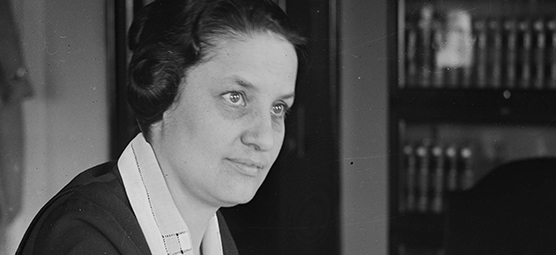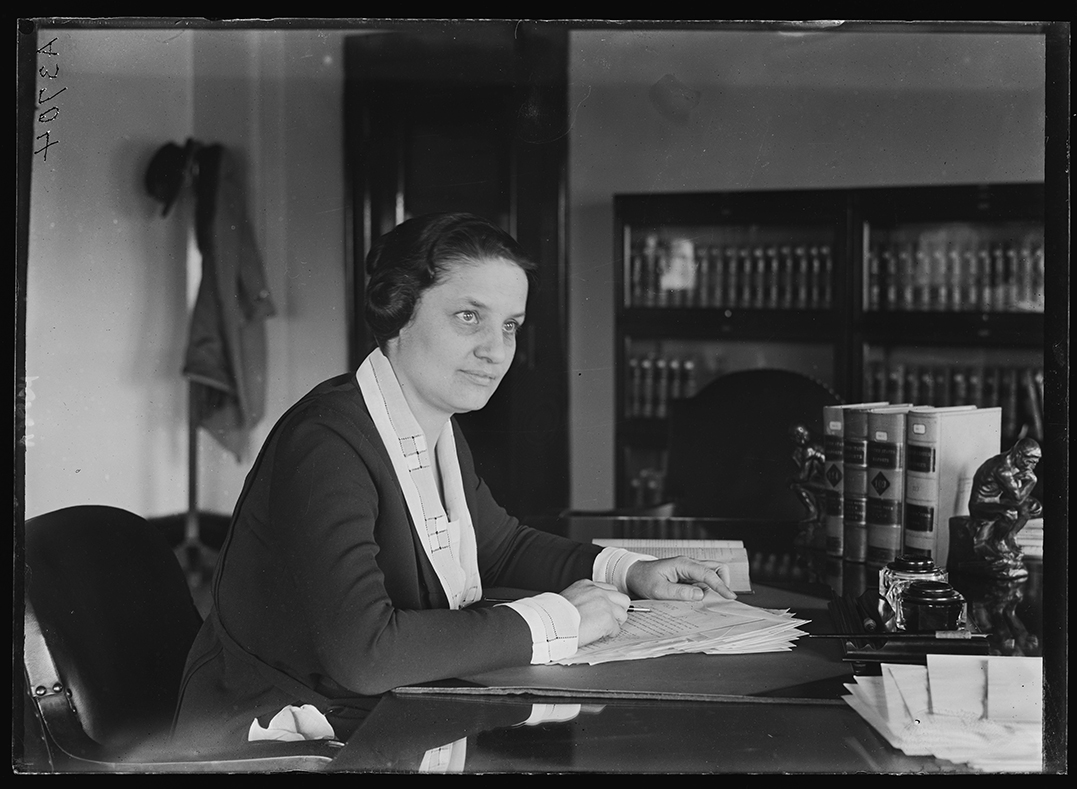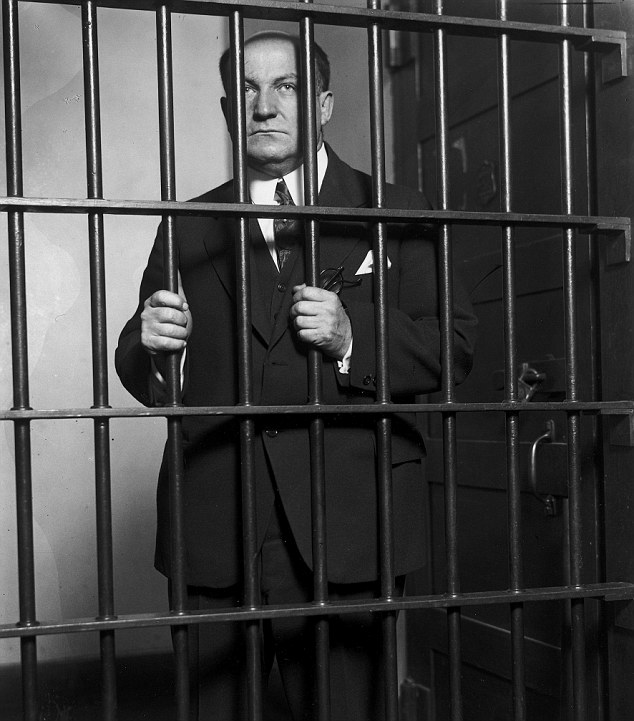Mabel Willebrandt: Prolific prosecutor of Prohibition laws
Most powerful woman in U.S. government during 1920s

Second in a series of profiles for Women’s History Month.
Mabel Walker Willebrandt, one-time public defender and tax lawyer to the stars, is best known as the highest-ranking woman in the U.S. government during the 1920s. As assistant attorney general, she steadfastly prosecuted the Volstead Act during Prohibition, sometimes using tax laws to put away top-level rumrunners.

Born in 1889 in Kansas, Mabel traveled in a covered wagon in 1893 to Oklahoma territory with her mother, Myrtle, and father, David Walker, a German immigrant and newspaper printer. The family moved to Missouri, where Mabel entered school at age 13 and proved to be a fast learner. Her family pulled up stakes to Michigan where she passed a school teacher’s exam without a college degree. While a teacher in 1910 she met and married her school’s principal, Arthur Willebrandt. Because of her new husband’s tuberculosis, they decided to leave for Arizona and its dry climate.
Mabel at the time suffered significant hearing loss and went to great lengths to hide her hearing aids beneath her hair. While in Tempe, Arizona, she suffered a miscarriage and could no longer have children. She worked as a teacher and finished her teaching degree at Arizona State University in 1911. She and Arthur moved to Los Angeles a year later. Mabel was appointed principal of an elementary school in Pasadena.
Within several years, after taking night classes part time, she earned a law degree from the University of Southern California. Mabel had supported Arthur while he took law classes full time, but her faith in their marriage ended when he declined to return the favor. They separated in 1916. She worked briefly as a defender in police court and then accepted an offer to be the first-ever female public defender in Los Angeles County. All the criminal cases she defended involved women, frequently those held on prostitution charges. She made her mark on about 2,000 cases. She insisted that charges had to be filed against the men who had hired the sex workers she defended.
In 1920, the Volstead Act took effect, prohibiting the importation and sale of intoxicating beverages. That year, Mabel had her parents move out to California. Her abilities in the criminal court bore out the expectations held by Frank Doherty, her law professor and mentor. Doherty convinced California U.S. Senator Hiram Johnson to recommend her to President Warren Harding, who was, like Mabel, a Republican. In 1921, a year after American women received the right to vote, Harding appointed her assistant attorney general. She was only 32 at the time and the second woman ever granted that post.
The position – for a modest $110-a-month salary, little more than her pay as a teacher – made her the highest-ranking woman in the U.S. government. Based in Washington, D.C., her assignment was to oversee prosecution of Volstead Act violators, as well as federal income tax litigation and the nation’s federal prisons. She started with a staff of three but grew it to about 100, including more than 40 lawyers.
While serving as assistant attorney general from 1921-29, Mabel was in the front lines in the unenviable position of enforcing the nation’s Prohibition laws with a limited budget and personnel. Her no-nonsense approach to implementing anti-liquor laws drew admiration from Prohibition supporters, who called her “the First Lady of the Law.” Her administration had a hand in many of the nearly 600,000 federal prosecutions related to the Volstead Act from 1920 to 1933.
A profile of her in Collier’s magazine in 1924 began this way: “I know a way to make a ‘wise’ bootlegger in the United States shiver in his boots. How? Easy! Just slip up behind him and whisper, ‘Mrs. Willebrandt is after you.’”
Willebrandt herself boasted, after taking her federal post, “Give me the authority and let me have my pick of 300 men and I’ll make this country as dry as it is humanly possible. There’s one way it can be done – get at the source of supply. I know them and I know how they could be cut off. I have no patience with this policy of going after the hip-pocket and speakeasy cases. That’s like trying to dry up the Atlantic Ocean with a blotter.”
She argued more than 40 cases before the Supreme Court, and won several victories regarding the control of liquor sales on both American and foreign vessels. In 1927, she argued before the Supreme Court that taxes should be paid on illegal income. She won the case and opened the door for the IRS to build tax evasion cases against Mob bosses, including Al Capone.
But her critics derided her for zeal as the nation’s strident “dry” prosecutor (she once said she saw herself as “an instrument of God”). New York Governor and Democratic Party presidential candidate Al Smith famously dubbed her “Prohibition Portia” while she campaigned for Republican incumbent President Herbert Hoover in 1928. During that election, Mabel ordered raids on illegal liquor businesses in New York City to embarrass Smith. Her devotion to Prohibition drove her to urge a crowd of Methodist bishops to oppose Smith, who was a Catholic, but she faced criticism for implying the Protestant clerics should exhort their followers to vote against Smith on religious grounds.
Her tireless effort to enforce anti-liquor laws blinded her to the reality that by the late 1920s, political opposition to Prohibition was growing. Allies of the temperance movement in the 1920s included the Woman’s Christian Temperance Union and a strange bedfellow, the Ku Klux Klan, both of which also favored the 19th Amendment granting women the vote. Mabel, ever the politician, knowing of this unholy alliance to keep things dry, once said of the Klan, “I have no objection to people dressing up in sheets, if they enjoy that sort of thing.”
Still, it must be remembered that Mabel was a formidable figure on a national stage dominated by men. Her longtime lawyer friend, John Sirica, later the federal judge who ordered the Nixon administration to release damaging White House tape recordings during the Watergate scandal in the 1970s, once said of her: “If Mabel had worn trousers, she could have been president.”

Many in Washington and throughout the country believed that enforcement of the Volstead Act would be lax. Mabel believed the law’s language made it difficult to apply. But she and her staff lawyers used it to aggressively pursue bootlegging rings. Her first major victory came in Cincinnati, Ohio, the lair of notorious bootlegger George Remus, who had beaten back efforts by local law enforcement to stop him. She sent in undercover agents who learned where Remus ran illicit distilleries, stored and transported liquor, sold forged liquor permits and sold doctored booze to drugstores. Mabel brought a case to trial against Remus to the U.S. Attorney’s Office in Cincinnati and it ended with Remus found guilty and sentenced to federal prison.
Mabel’s efforts cracked an even larger bootlegging case in Savanna, Georgia, a ring known as the Big Four led by Willie Haar. The Big Four’s sales operation was enormous, pulling in millions of dollars a year, involving a fleet of ships importing liquor to 10 to 15 states delivered by trucks, trains and cars. The ring also had a list of deputies, judges, politicians and even Prohibition agents on its payroll to look the other way. News of the Big Four spread throughout the country, and Washington asked Willebrandt to take up the case. Working with Bureau of Investigation head William J. Burns, she sent bureau agents to Savanna but soon realized that agents from the Treasury Department there were not cooperating. She assigned a group of bureau agents to the city to work undercover.
An examination of Haar’s business records revealed he owed more than $1 million in back federal income taxes and his gang nearly a million more. The tax evasion investigation resulted in criminal charges and dozens of arrests. After a trial in federal court, Haar and the other three of the Big Four were convicted along with 64 others in the ring. It was the end of the largest illegal bootlegging operation of the time.
Also among Mabel’s biggest successes in enforcing Volstead was on the coast of Florida, the so-called “Rum Row,” a primary transit hub for speedboats transporting bootlegged liquor. She met with Treasury’s Prohibition unit, the U.S. Coast Guard, Customs Service and her staff to hatch a plan to halt rum running in Florida. After the meeting, Mabel wrote later that with the Coast Guard on board against the racketeers, “Congress was aroused. In a few weeks’ time, an addition $11 million was appropriated for boats and equipment.” The Guard used a fleet of 203, 75-foot boats to harass rumrunners and prevent them from leaving international waters 12 miles out to deliver their supplies of booze to awaiting smaller boats.
While in the Justice Department, Mable used her position to press for reforms in the nation’s prisons, which were perhaps even more important than her work against liquor racketeers. She fought for establishing the first federal prison for young males convicted for the first time. The facility, the United States Industrial Reformatory, opened in 1926 in Ohio. After hearing from women’s groups calling for a federal penitentiary for women, Willebrandt successfully lobbied Congress to pass a law in 1924 for one and the first federal facility for women opened in 1927 in West Virginia. She is also credited for initiating industrial programs for U.S. prison inmates in 1926, starting with a prison shop in Atlanta making canvas bags for post offices and a shoe shop at Leavenworth prison in Kansas in 1926. It was the precursor of the Federal Prison Industries program, created in 1934 by President Franklin Roosevelt and continues today. She also started the first record keeping of federal inmate populations in 1926.
Even though the overall consumption of alcohol in America declined during Prohibition, by the late 1920s the public’s mood was changing and many early supporters switched sides, seeing that the grand experiment had failed. Ordinary people almost everywhere openly flouted the law. And besides, well-known gangsters such as Al Capone, Bugs Moran, Jack “Legs” Diamond, Frank Costello, Charles Luciano, Meyer Lansky and Moe Dalitz, were having their way making, importing and selling illegal beer, wine and spirits throughout the United States, and the Justice Department could not stop them.
In 1929, after Hoover was re-elected over “wet” advocate Smith, Willebrandt was disappointed to learn the president would not make her his attorney general, nor grant her a judicial appointment. She decided to resign, telling Hoover in a letter of an offer she had received from the Aviation Corporation to be its legal counsel in Washington to secure uniform laws and investments in the emerging commercial aviation industry.
Now out of government, and Prohibition still the law, her first legal client was California Fruit Industries, a wine juice maker. The Volstead Act permitted individuals to make up to 200 gallons of wine per year for personal consumption. Her choice of client may have surprised her pro-temperance friends, but it was perhaps a shrewd if predictable move on Mabel’s part – working as a lobbyist for an industry she once regulated.
In 1930, Mabel posed for a photograph with famous aviatrix Amelia Earhart while promoting commercial air travel. In the 1930s, Mabel was a close friend of the film studio head Louis B. Mayer and defended him in a tax delinquency case that resulted in a large tax refund for Mayer. Her work with Mayer gained her other Hollywood clients, including actors Jean Harlow, Clark Gable and Jeanette MacDonald. She also was counsel for the Screen Directors Guild from the 1930s to the 1950s.
Willebrandt died in 1963. She faded into history until a character based on her in the 2010-2014 HBO series Boardwalk Empire, set in Atlantic City during Prohibition, renewed interest in her legacy.
Feedback or questions? Email blog@themobmuseum.org





